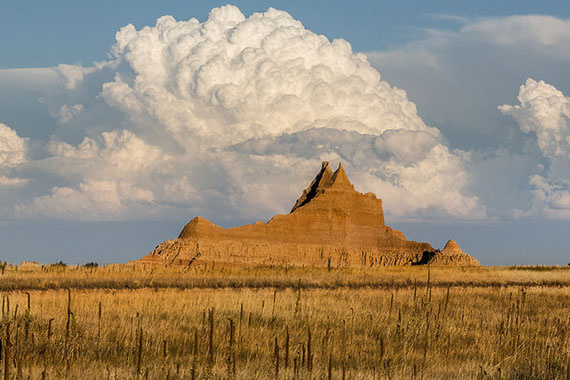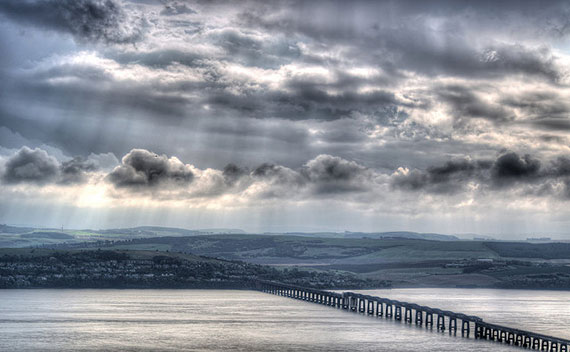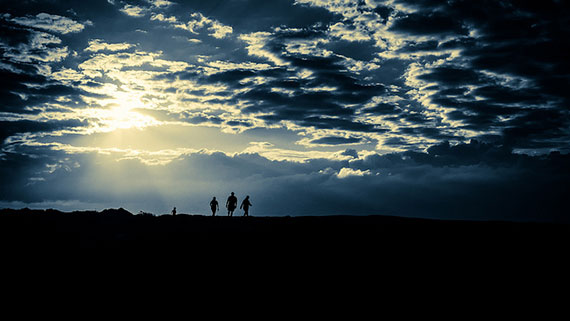How many beautiful nature pictures have we all seen with little or none of the sky-scape? You may think of the sky as only some unavoidable background for most of your nature photo subject matter, and the more blue it is, the better. Well guess what? Mother Nature has a treasure trove of eye catching possibilities up, overhead if you only take the time to have a look and know what to look for.

Photo by Christian Collins; ISO 100, f/9.0, 1/400-second exposure.
Lets start with the basics. Obviously, a beautiful clear, deep blue sky makes for a good backdrop for many subjects but can be rather dull by itself, as can a completely gray overcast sky. Now start adding fluffy white cumulus clouds and it starts getting more interesting, but it is only the beginning of the many opportunities the sky can provide for unique and pleasing photos.
Take fair weather cirrus and stratus clouds for instance. Their thinner and more spread out nature can provide a completely different look for your photo. Even at mid-day the sky can be gorgeous. For example an approaching thundershower can be striking with the billowing and ever changing shapes and textures, and bright white color as it approaches. It is like a mountain-canyon vista in the sky, and is easily captured compared to other faster moving, unpredictable subject matter. And you will have no problem capturing multiple, unique shots of the storm before it moves off or overhead because of its continual morphing of shapes and colors. Also some clear skies around the storm can add to its magnificence and enhance your image.
Using a digital camera for capturing mid-day storms is easy since auto mode frequently works well at adjusting the cameras ISO setting (light sensitivity), preventing overexposure of the clouds white colors and preserving the definition of their many shapes and edges. Some cameras may not do this as well as others, so manually adjusting the ISO setting may be required for best results.
Always remember when taking full sky-scape shots to have a clean sky, meaning nothing obscuring the view such as trees, buildings, power lines, etc. Of course those objects can work great in their own compositions, but at the moment we are concentrating on that big empty space overhead.

Photo by Neil Williamson; ISO 100, f/8.0, 1/321-second exposure.
Dusk and dawn sky shots are definitely the most colorful and one of my favorites. Sure, clear sunrises and sunsets are nice, but by far the best is when you have high, wispy, cirrus clouds, and mid level stratus to reflect the suns beautiful and ever changing colors as it rises or sets. Lower puffers or cumulus can add some nice contrast as long as they do not block the view of the higher ones which reflect most of the colors. All this is most easily captured over water or a flat landscape with no obstructions. A water vista often works best because of the additional color reflections.
I have found that the deepest reds and purples are from about 15-20 minutes before sunrise and after sunset, with the oranges and yellows occurring shortly before rise and set. Of course a vertically building cumulus cloud will reflect stunning colors as well during these times. I have seen large cumulus and stratus clouds light the area up like you were in a giant red, pink, or orange room, then fade away as the suns rays leaves them and hit the higher clouds.
You will want to make sure your cameras ISO setting in auto mode is adequate for the conditions when working in lower light levels. If not, try manually adjusting the setting to increase the cameras light sensitivity. Settings can vary from camera to camera, but you will be able to see when it looks right. This is when the sky still looks natural, not too bright or glowing, and not too dark or fuzzy. Try to match what the camera is picking up with what you see with your own eyes. Low light conditions can be tricky so take your time, being careful not to overexpose.

Photo by Jason Carpenter; ISO 800, f/11.0, 1/4000-second exposure.
Hopefully this information will encourage you to get out there with your camera and explore a part of nature that is often overlooked.
About the Author:
John King (Everglades Photography) is a pilot and amateur photographer residing in South Florida. His interests include kayaking, sailing, and nature photography, and he has recently completed the coastal portion of the Florida Master Naturalist Course.
Go to full article: Sky Photography Tips and Techniques
What are your thoughts on this article? Join the discussion on Facebook
PictureCorrect subscribers can also learn more today with our #1 bestseller: The Photography Tutorial eBook
The post Sky Photography Tips and Techniques appeared first on PictureCorrect.
from PictureCorrect http://bit.ly/2ykRoJY
via IFTTT






0 kommenttia:
Lähetä kommentti